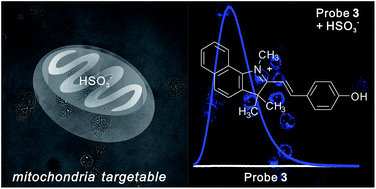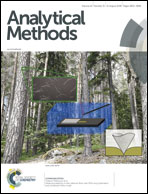A mitochondria-targetable fluorescent probe for detection of bisulfite in living cells†
Abstract
A new colorimetric semi-cyanine fluorescent probe (3) based on benzo[g]indolium was designed and prepared. Probe 3 exhibited a clear OFF–ON fluorescence response at 460 nm toward HSO3− (0–8.0 eq.) within a short response time (3 min). In addition, probe 3 had good selectivity and competitiveness, with excellent sensitivity and a low detection limit (4.4 nM). The detection mechanism relied on nucleophilic HSO3− attacking the C![[double bond, length as m-dash]](https://www.rsc.org/images/entities/char_e001.gif) C double bond in a 1,4-nucleophilic addition reaction. Importantly, the confocal fluorescence results indicated that probe 3 targeted mitochondria and could detect HSO3− in living cells.
C double bond in a 1,4-nucleophilic addition reaction. Importantly, the confocal fluorescence results indicated that probe 3 targeted mitochondria and could detect HSO3− in living cells.



 Please wait while we load your content...
Please wait while we load your content...